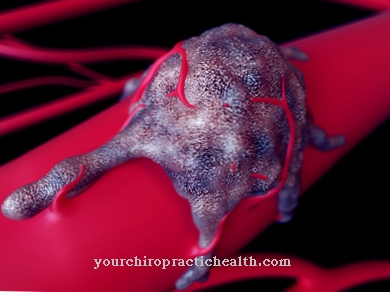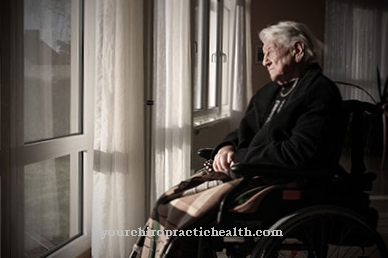After suffering a wound, there may be a in the wound area Wound infection come. In the past, all forms of wound infections were also mentioned Gangrene. If a wound infection could not be prevented in time, this infection usually requires targeted therapeutic treatment.
What is a wound infection?

From one Wound infection is spoken in medicine when a wound becomes infected due to invading microorganisms. Such a wound infection usually manifests itself, for example, through an inflammatory process in the wound area.
A wound infection is assigned to the so-called wound healing disorders. Wounds that have suffered extensive tissue loss (as can happen as a result of severe burns or as a result of dog bites) are particularly prone to the occurrence of a wound infection.
This is due, among other things, to the fact that such wounds often cannot be sutured, but have to heal naturally. Healing can take up to a few months and the wound is therefore susceptible to the penetration of harmful microorganisms.
A special form of wound infection is the MRSA infection or the nosocomial infection. Due to the increasing frequency of antibiotic resistance, methicillin-resistant bacteria, such as staphylococcus aureus, occur particularly in unsanitary hospitals.
causes
Corresponding microorganisms that lead to a Wound infection are in most cases pathogenic bacteria (bacteria that can cause disease). More rarely, viruses or parasites that penetrate a wound can also be responsible for the development of a wound infection.
However, penetration of the corresponding bacteria, viruses or parasites does not always lead to wound infection; Whether an infection occurs depends, among other things, on the type of pathogen that has penetrated, its number and also on the immune system of the patient concerned.
If bacteria are the cause of a wound infection, such an infection can manifest itself in different forms: So-called cocci (spherical bacteria), for example, usually lead to pronounced pus formation in the wound area, while putrefactive bacteria often cause a characteristic odor that is associated with a wound infection.
Symptoms, ailments & signs
An existing wound infection is usually accompanied by fairly straightforward symptoms that can cause significant pain. As a rule, a wound infection is always associated with severe reddening of the affected area. Affected people can see such redness with the naked eye. In some cases, a visible swelling can also be seen, which also appears directly on the wound.
Another and fairly clear symptom is the formation of pus fluid. The formation of pus is very common with a wound infection, as it is a sign of severe inflammation. Anyone who decides on medical and drug treatment at this point is making the right choice. This is because such treatment is essential in the event of a wound infection, as otherwise the symptoms can worsen considerably.
The infection may spread throughout the body, creating a risk of blood poisoning. In some cases, an abscess forms on the wound. This is a cavity that fills with pus fluid. The pressure inside increases over time, so that the pus fluid can get into the bloodstream. Such an abscess is also visible to the naked eye and should be treated by a doctor as soon as possible.
Diagnosis & course
First of all, a Wound infection diagnosed using what is known as microbiological evidence. For this purpose, for example, smears are taken from the wound area and tested for an existing wound infection.
Other diagnostic methods to confirm the presence of a wound infection can, if necessary, include x-rays or ultrasound: The x-ray method can, for example, show pus foci that have formed as part of a wound infection to a limited extent. The ultrasound method can also be used to detect fluids that have accumulated in the wound area; Before this diagnostic examination, the ultrasound head is usually disinfected.
The course of a wound infection depends on various factors. The type of trigger of a wound infection plays a role here. In addition, an early start of treatment and appropriate medical treatment can have a positive effect on the course of a wound infection.
Complications
A wound infection can lead to complications, most of which are related to the size of the wound and wound hygiene. Proper wound care with constant checks and medical care, however, excludes complications in most cases.
Infection of a wound always means a point of attack for other pathogens that colonize the wound in the event of inadequate hygiene or exposure. They lead to poorer healing of the wound, cause typical infection symptoms or exacerbate existing symptoms. If the wound is large and damaged to such an extent that the body can no longer heal the wound, surgical procedures must be considered for the sake of health. Amputations and partial amputations can be necessary in severe cases.
In addition, a poorly hygienic wound increases the risk of blood poisoning and the associated sepsis. This condition is always life-threatening and in severe cases hardly treatable. If not medically treated, such gangrene leads to the death of the person concerned.
In addition, a deep wound infection can, depending on the location, lead to consequential damage that affects muscles and nerves, among other things. Loss of function in the affected area, especially with wounds that are difficult to heal, can occur. The risk of all complications in this context can be reduced with adequate hygiene measures.
When should you go to the doctor?
Usually wounds heal slowly and steadily. A doctor is not required if the wound is continuously improving over several days and existing symptoms are reduced. However, if there is an increase in health problems or other irregularities develop, a medical examination is required. If there is swelling in the area of the wound or severe reddening, action is required. As sepsis can occur if the outcome is unfavorable, it is necessary to consult a doctor.
Blood poisoning is a potentially life-threatening condition. A doctor should therefore be consulted if general health deteriorates within a short period of time. If you have a fever or pus, this is cause for concern. If an abscess develops, a doctor's visit is necessary. If rapid changes in health occur within a few minutes, a hospital must be visited immediately.
If the person concerned complains of pain, sudden severe tiredness or a decrease in physical strength, this should be investigated. If you feel unwell or feel generally ill, there is a health disorder that needs to be examined and treated. Irritation, severe restriction of movement and over-sensitivity to touch are signs of an existing irregularity. This must be clarified by a doctor.
Treatment & Therapy
In the medical treatment of a Wound infection The first step is often a so-called wound revision, i.e. a detailed examination of the wound infection. This wound inspection is intended, for example, to provide information about the depths of a wound that a corresponding wound infection has already penetrated and to what extent the wound is soiled.
Furthermore, as part of the wound revision, it is checked whether the existing wound infection may have affected blood vessels, nerves or body cavities. As part of a subsequent surgical treatment of the wound infection, dead tissue in the wound area is removed if necessary.
If a wound infection is accompanied by excessive oozing of the affected wound, another possible therapeutic measure is the placement of a so-called wound drainage system, i.e. a form of drainage system through which tissue fluids can be drained to the outside. A wound infection is often subsequently treated in the form of a daily dressing change, for which, among other things, sterile (aseptic) dressing material must be used.
In rare cases, the wound infection can spread and cause sepsis (blood poisoning). If this is the case, an additional dose of antibiotics may be necessary.
prevention
To one Wound infection To prevent this, a wound should first be quickly cleaned and treated. Depending on the severity of a wound, it can make sense to consult the attending physician early in case of doubt in order to guarantee professional wound care and to prevent wound infection.
Aftercare
Serious complications can occur if the wound becomes infected. In the worst case, the patient risks blood poisoning. Therefore, wound infections must be treated with special care. First of all, it is important to protect the wound from external influences in everyday life. It is essential to avoid contamination. For this reason, the wound should be covered over a large area.
This is done with the help of appropriate plasters or, in the case of larger wounds, with a wound dressing that should be checked and changed regularly. If the secretion of wound fluid increases, this must be clarified with the treating doctor. The type and frequency of dressing changes should also be discussed with the doctor. In order to promote wound healing, bandages must be applied in such a way that there is no feeling of tension in the affected region.
The resulting stretching of the skin could lead to further disturbances and enlarge the wound or impair the wound healing process. Movement and motor skills should be adjusted accordingly while the wound is healing and possible overexertion should be avoided. It is often advisable to stop exercising completely while healing. In order to support the organism in recovery, attention should be paid to a healthy lifestyle. A balanced diet and sufficient intake of vitamins and fluids help here
You can do that yourself
Particular care must be taken in the event of wound infection. In order not to risk blood poisoning, it is important to closely monitor health developments. In the event of an increase in complaints or general irregularities, a doctor must be consulted. Otherwise, it can lead to an acute condition and premature death.
In everyday life it is important to ensure that the wound is protected from external influences. In particular, contamination must be avoided. For this reason, the affected area should be generously covered or secured against contact. The wound dressing should be checked and changed at regular intervals. If there is an increase in wound fluid, action is required. If you are unsure about the correct procedure for changing a dressing, you should consult your doctor.
During the general movement sequences, it is important to ensure that no feelings of tension arise. These can lead to stretching of the skin and thus to disorders. There is a threat of an enlargement of the existing wound or impairment in the ongoing healing process. It is therefore important to adapt the motor skills to the health conditions and to avoid overloading. It is therefore often necessary to refrain from sporting activities completely during the recovery period.
Sufficient vitamins should be supplied to the body to support healing. It is therefore important to ensure a balanced diet.






.jpg)





.jpg)



.jpg)










.jpg)
